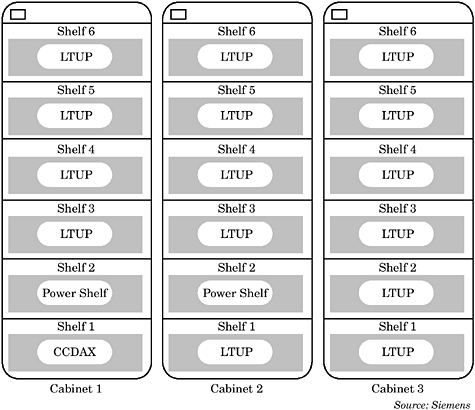There are several types of PBX system cabinets, categorized by carrier size and function. A system cabinet may be a single-carrier or multicarrier cabinet. Most very small PBX models are based on a single-carrier cabinet common equipment design. The wall-mountable single-carrier cabinets are sometimes referred to as modules. Single-carrier cabinet designs are typically targeted at customers with port size requirements of fewer than 100 stations. The Avaya Definity One model is representative of this design type. Customers with port size requirements between 100 and 400 stations are usually supported by stackable carri- er designs including a control carrier and a few expansion port carriers, like the Nortel Networks Meridian 1 Option 11C model. Some PBX manufacturers also use a stackable cabinet design for intermediate and large system configurations, like the NEC NEAX2400 IPX that can support port capacity requirements approaching 20,000 stations. Multicarrier cabinet designs, which are not cost effective for small and intermediate line size customers, are fairly prevalent in the large and very large line size market. For example, the small/intermediate line size Hicom 300H Model 30 from Siemens is based on a stackable carrier design, but the larger Hicom 300H Model 80 is based on a six-carrier shelf cabinet design (Figure 1).

Major cost benefits of the new client/server IP-PBX system designs are due to minimal telephony system cabinet requirements. A 100 percent IP desktop configuration may consist of a single server cabinet with integrated gateways for PSTN trunk access because port cabinets and port circuit interface cards are not required. The switching functions, however, are dependent on Ethernet switch carrier shelves or stackable carrier cabinets, but in almost all situations these common equipment components have been installed to support data communications applications. The migration from a traditional circuit-switched PBX design to the emerging IP-PBX designs will slowly reduce common equipment requirements dedicated solely to telephony applications.
The first generation of digital PBX systems was based on multicarrier cabinets. Multicarrier cabinet designs are still used for many large and very large PBX system models. A multicarrier cabinet typically has four to six carrier shelves. The primary cabinet, often referred to as the control cabinet, houses the common control complex, the center stage switch complex (if incorporated into the switch network design), and may also house port circuit cards. Expansion cabinets, often referred to as port cabinets, house the bulk of the port circuit interface cards. The typical number of printed circuit board slots is between 16 and 20 per carrier shelf. Although the number of carrier shelves and card slots has remained relatively constant during the past 15 years, port cabinet density has increased significantly because port circuit interface card density has increased. Several currently available expansion port cabinets can house between 60 and 100 port circuit interface cards, with each card typically supporting 24 port interfaces. Simple mathematics indicates that a single port cabinet can support between 1,000 and 2,000 stations with associated trunking. Port cabinets during the early 1980s were usually restricted to a few hundred ports.
The first stackable PBX system cabinet design was introduced by NEC in 1983. The original NEC NEAX2400 was an evolutionary design because it offered an cabinet design alternative to traditional multicarrier cabinets. A stackable cabinet design offers customers several benefits:
-
Optimizes common equipment requirements—Before the stackable cabinet design, a customer might have installed a full-size multicarrier cabinet but use a fraction of the available carriers and card slots. Unless a customer had near-term growth requirements, too much hardware was installed to satisfy port requirements at system installation.
-
Reduces common equipment costs—Stackable cabinets more cost effectively satisfy customer port size requirements.
-
Simplifies system upgrade and enhancements—Customer port growth may be accommodated easily by adding another port carrier cabinet. Manufacturer design changes can focus on individual carriers, so that customers can perform system upgrades by changing out one or two carriers, instead of replacing multicarrier cabinets.
The single-carrier cabinet design is most popular for PBX systems targeted at customers with very small to intermediate line size requirements, although a few manufacturers use the stackable cabinet design for their large and very large system models. NEC, the innovator of the stackable carrier cabinet design, uses stackable single carrier cabinets for its small/intermediate NEAX2000 IVS2 system and its intermediate to very large NEAX2400 IPX models.

No comments:
Post a Comment